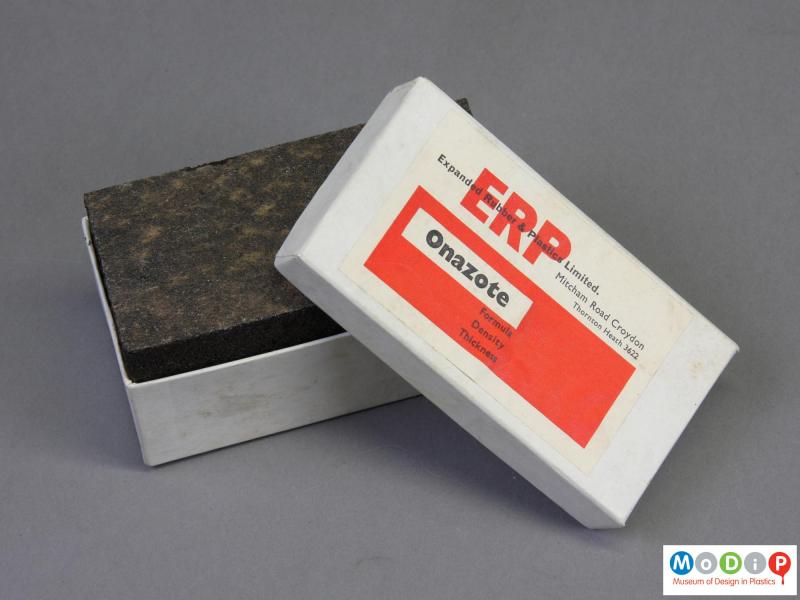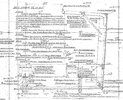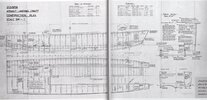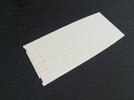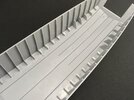The wording of the description that you posted was very vague ( not you

) , some of us thought it was solid, other like me thought ply.
I also thought it would be plywood, but following Peter’s comments I suspect it was planks. That could make a difference to the model, because with planks you might “have” to scribe the seams between them. OTOH, I’ve not been able to spot any in photos, so …
I'd guess the latter. The door hinges seem to be riveted to reinforcement bar (angle iron?) which wouldn't be necessary if there was already a steel frame.
Quite possibly, yes. Not that it matters for modelling, but it’s nice to speculate

As for the model … I thought I’d be clever and size the drawings to 1:35 scale, then print them out, so I have an easy reference that I can just measure in directly. But look:
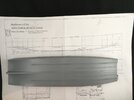
I made a mistake somewhere, so that the drawings are too large

I guess I’ll have to give it a second try and return to the museum in Westkapelle to print them out again — the boat is big enough that you need an A3 sheet to fit it on, and I don’t have an A3 printer

You could of course print out both halves on A4 and stick them together, but a single sheet is easier to work with.
That slight setback discovered, I took another good look at the floor parts, and decided that I will need to replace the whole troop compartment floor. It needs to run from frame 5 to 16, but the kit floor goes from about 6.5 to 16. What I did was trace the kit part onto a piece of 1 mm plastic card using the tip of a knife:
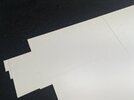
The pencil line is how long the floor needs to be. After cutting it out:
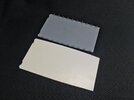
Trying it in the hull, you can see it’s now the right length:
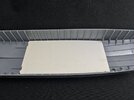
But it can’t fit between the frames, because it doesn’t have the cut-outs that the kit floor does. I first tried putting those in, but that’s fraught with problems. Then it hit me that I don’t need to add them at all, because I will be adding floatation cells between the frames — meaning I can just cut off the edges so the floor fits
between the upright parts of the frames. I put the kit floor onto my replacement again, held it down tightly and used a sharp needle to prick at the end of the cut-outs in the kit part. Then I could just connect the marks with a knife and steel ruler:
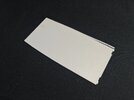
Marked at the bottom, cut at the top. That just left the front part, for which I just measured the distance between the ribs. With the sides cut off, the floor fits inside the hull:
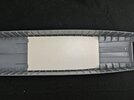
And the difference with the kit part:
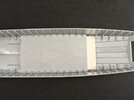
Then the planking. It turns out the kit’s planks are 4 mm wide, and I saw no good reason to deviate from that, so I just marked out the centreline and then a line every 4 mm:
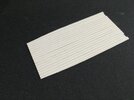
All that was left to do was go over the lines with a
Tamiya plastic cutter/scriber/whatever:
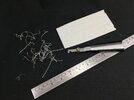
I decided I could also salvage the forward part of the kit’s front floor:
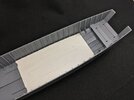
I simply cut it off at the third frame, and will now have to build the sloping floor and the floors for the steering and MG positions as well.

 That’s an American LCV (Landing Craft, Vehicle), if I’m not mistaken — same sort of size as an LCA, but intended for delivering a one-ton truck or 36 troops ashore. The LCA also carried 36 troops, but couldn’t take vehicles because of its narrow bow ramp. The LCV was improved to become the LCVP, mainly by moving the steering position from on top of the rear deck (it’s the grey rectangular thing behind the stairs in the photo) to inside the hull alongside the engine, and adding two gunner’s positions behind the engine compartment.
That’s an American LCV (Landing Craft, Vehicle), if I’m not mistaken — same sort of size as an LCA, but intended for delivering a one-ton truck or 36 troops ashore. The LCA also carried 36 troops, but couldn’t take vehicles because of its narrow bow ramp. The LCV was improved to become the LCVP, mainly by moving the steering position from on top of the rear deck (it’s the grey rectangular thing behind the stairs in the photo) to inside the hull alongside the engine, and adding two gunner’s positions behind the engine compartment.
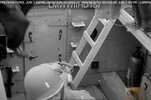

 I guess I’ll have to give it a second try and return to the museum in Westkapelle to print them out again — the boat is big enough that you need an A3 sheet to fit it on, and I don’t have an A3 printer
I guess I’ll have to give it a second try and return to the museum in Westkapelle to print them out again — the boat is big enough that you need an A3 sheet to fit it on, and I don’t have an A3 printer 








